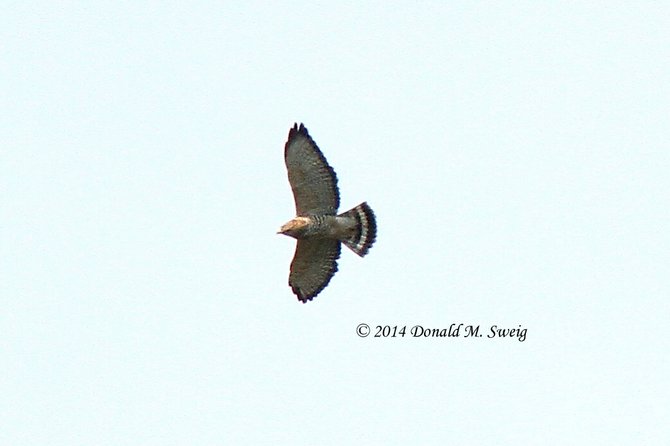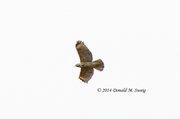Adult Broad-winged hawk over Great Falls. Notice the wide, white band in the tail and the black edge at the back of the wing. The annual migration of Broad-winged Hawks passes through our area approximately Sept. 12-22. Photo by Donald Sweig
Every Autumn, in addition to literally billions of songbirds, a million or more avian raptors (hawks, eagles, and falcons) migrate from their nesting and breeding areas all over North America to their winter homes, mostly in Central and South America. Raptor enthusiasts and hawk counters often head for mountain ridges and other concentration points in hopes of seeing some of the birds fly by.
But, one doesn’t necessarily have to do this to see migrating hawks.
Broad-winged hawks often migrate in large groups and very large numbers. At the right time, with the right weather, it is possible to see lots of them almost anywhere. Peak migration for Broad-winged hawks in the mid-Atlantic states is usually between Sept. 12 and 22.
Sept. 18-19 are often the big days in the Washington area.
It is helpful to understand a little about how Broad-winged hawks migrate.
“Broadwings,” like some other raptors, don’t fly well over long distances.
So they utilize “thermals,” rising columns of hot air off the land, to help them gain altitude for migration.
When a migrating Broadwing, for example, starts out in the morning from a place like the wooded hills along the Potomac River near Great Falls, it will flap a few times to get out of the trees and then it begins to look for a thermal. When it finds one, it sort of sits in the column of rising air and often makes little circles to stay in the thermal as it rises with the air, something like an elevator. If a second Broadwing sees the first one, it may well take off, flap a bit, and join the same thermal as the first bird; and so forth. Soon there may be five or 10, or more (often many more) birds in the same thermal.
Eventually, the hawks will reach the top of the thermal and just mill around in it before gliding off to look for another thermal. When one sees a number of Broadwings together in a thermal, it is called a “kettle.”
LOOK AT THE SKY, especially clouds, and preferably with binoculars anytime you can in mid-September. If you see a bunch of birds swirling around together in a cloud, or in the clear sky, you probably have a “kettle” of Broadwings. And, one really can see them almost anywhere. It’s a serendipitous happening.
There are also avian pathways that the birds often use, like perhaps a highway, as they migrate south.
There is nothing definite or conclusive about such pathways. It’s just matter of where one has in the past most often seen the migrating Broad-winged hawks. There seems to be such a migration pathway crossing the Potomac River
from somewhere between the American Legion Bridge and Chain Bridge, upriver to at least Violette’s Lock on the C&O Canal.
In past years, I have seen very large concentrations of Broad-winged hawks even over congested Northern Virginia: over the Tysons Mall, over the Fairfax County Government center, over the Town of Vienna.
Three years ago, several birding friends and I were just finishing some early morning birding in the meadow at Riverbend Park in Great Falls, when someone looked up and said “look!”
We all did and saw a big kettle of Broad-winged hawks. As they started to “stream out,” we saw another kettle coming in. We stood there for perhaps 20 to 30 minutes and watched at least 2,000 Broad-winged hawks migrate by.
It was a veritable “river of raptors.” It was the most I had ever seen. The next morning, at the same place, I saw none at all.
It was pure serendipity.
THE BEST TIMES to look for migrating Broad-winged hawks is between Sept. 12-22 in the morning from between about 9 and 10, when they get up to start flying, and in the late afternoon, after 5, when they often come down for the night.
I often have good luck at places like the Great Falls National Park, especially on the Maryland side. The many trees there are attractive to Broadwings for overnight roosting.
But one can see them almost anywhere, even in your own neighborhood, as I have in mine in Northern Virginia.
One doesn’t always see them when you look. But, if you do, it is a memorable experience.
Broad-winged hawk and other raptor migration is an integral part of the annual flow of natural happenings.
Keep your eyes on the sky. You may be well rewarded.

